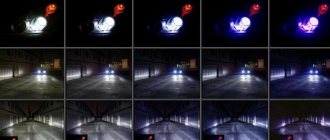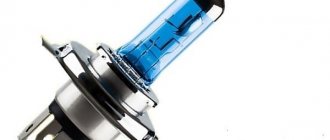Each of the car owners has their own driving experience: some have been turning the steering wheel for ten years, while others just recently received their license. When driving a vehicle in the dark, any driver wants to see more and further, since bright light allows him to orient himself on the roadway in a timely manner.
And to solve this problem, many car owners install xenon lamps. However, law enforcement officers can fine you for xenon.
That is why every interested driver should know how to install xenon so that traffic police officers do not deprive of their license.
Types of lighting fixtures for cars
Cars use 3 types of optics: halogen lamps, LED lights and xenon. Halogen ones work for 500-1000 hours, get very hot and produce a weak luminous flux compared to alternative options. LEDs and xenon are bright and reliable options. LEDs are more expensive, but they provide an intense luminous flux, operate for 30,000-40,000 hours, heat up less, and do not lead to excessive fuel consumption. Xenon is not cheap, operates for 3000-4000 hours, also does not overheat and provides a uniform light fill.
Removal
Kit
Of course, without dismantling the old headlights it will be impossible to install xenon devices. Dismantling is performed as follows.
- The vehicle is deprived of power by removing the negative terminal from the battery.
- The connectors going to the headlights are disconnected. All without exception.
- The fasteners are removed from the top mount. The bolts are located there.
- The radiator grille is dismantled.
- The bolt that holds the headlight unit in its lower part is removed. He's there alone.
- Next, pry up the cover using a flat-head screwdriver and remove it.
- Now take a 10 mm wrench and use it to remove the fixing nut to the bracket.
- All that remains is to remove the headlight unit.
- Do not forget to pry the hydraulic correction cylinder retainer using the same flat-head screwdriver to remove the unit.
- The direction indicators are removed. To do this, simply unscrew a couple of bolts.
Advantages of xenon
Xenon was the first halogen alternative to hit the market, followed by LEDs in the auto industry. At the initial stage, they did not compete with xenon in terms of glow intensity and other parameters, but thanks to scientific developments, LED optics received characteristics similar to xenon, at a relatively affordable price. LED headlights have taken the lead and become the leader in road use. Despite this, some motorists remain faithful to xenon and bi-xenon headlights.
- Xenon produces a bright light output of up to 6000 lumens;
- the level of illumination almost coincides with sunlight, the sun gives a white-blue glow, so visibility with xenon is close to daylight;
- Xenon headlights are used as a tuning element; such car lights are chosen because they cost and look expensive even on an inexpensive car.
Benefits and Potential Problems
Bi-xenon does an excellent job of illuminating the roadway and adjacent areas. This applies to both headlights and fog lights. A characteristic feature of xenon is that it emits bright white light with a blue tint.
Xenon in headlights and PTF
Fog lights from Bosch, which are installed on the VAZ 2110, do not have lenses. Instead, reflectors are provided here. This makes the beam of light not low enough.
Therefore, when installing xenon, it is very important to install focusing lenses so that the bi-xenon behaves appropriately. That is, it illuminated the road efficiently and did not blind oncoming cars.
Disadvantages of xenon
Despite the advantages, there are disadvantages due to which car owners often choose LED headlights.
- Not all xenon is permitted by law. The traffic regulations do not directly prohibit such optics, and LED headlights may be illegal if they blind oncoming traffic. Only standard factory xenon is officially allowed. Legislation allows the use of white, yellow and orange, so the blue glow of xenon raises questions among inspectors.
- Complicated installation. The car's standard system cannot withstand the voltage required to ignite and keep the lamp glowing. For this reason, additional ignition units are installed; they are bulky and do not fit into the headlight; the part has to be placed outside.
- Increased fuel consumption. Let’s make a reservation right away that we are talking about an increase of 0.1 liters per 100 km, but this is worth taking into account.
- High price of equipment. Even a homemade version will not be cheap, not to mention high-quality factory headlights . The color of xenon whitens over time, so if one lamp fails, you will have to change both, otherwise the light will differ.
- Mandatory presence of automatic headlight range adjustment.
Safety precautions when installing xenon
During the installation of xenon, some difficulties may arise, so you should be prepared for complications:
- Work must be stopped immediately in cases where there is obvious damage to lamps, ignition units or wires.
- Before installation, you must wash your hands thoroughly, because greasy, oily or wet fingers can not only render the lamps unusable, but also increase the risk of electric shock.
- All wire connections must be carefully insulated with high-quality electrical tape, because contact with water can lead to a fire.
- It is not recommended to look at working xenon headlights for a long time, as there is a possibility of damaging your eyesight. This can only be done with tinted glasses.
- Before installation, be sure to degrease the lamp bulbs using a cloth and alcohol.
As you can see, installing xenon is not such a difficult undertaking, and you can do it yourself. You just need to take this issue seriously and follow our recommendations step by step.
Installation options
The main condition is that the low and high beam headlights allow you to install xenon lamps or replace standard headlights with bi-xenon ones , for example. Installing xenon in daytime running lights is impossible, because they cannot be made brighter than low beam lights. There are administrative fines for installing gas-discharge lamps in fog lights; read about this in the article: “Is it possible to install xenon in fog lights?”
What are xenon headlights?
Scientists have long known the properties of xenon gas. One feature did not allow the specialists to sleep peacefully. If a powerful electric discharge was passed through the gas, it gave a very bright glow. Soon, automobile manufacturers used this feature of xenon to create bright and high-quality lamps that are a powerful source of light.
Due to the fact that the gas is colorless, it was decided to seal it in a transparent flask, through which a powerful electric discharge was passed. The advantage of xenon headlights over any other is that they shine close to the natural light source.
Xenon gas lamps have optimal light transmission and allow the driver to illuminate the road in front of the car as widely as possible while driving at night. Xenon lamps are popular due to the fact that they can be installed on almost any car equipped with halogen headlights.
If you wish, installing xenon on your car yourself does not take much free time. All operations can be performed independently and without outside help. The operating efficiency of xenon light elements is noticeably superior to all currently existing devices.
New rules
From January 25, 2020, the traffic police post can check which lamps are installed in the headlights of a car. If a discrepancy is detected, the inspector draws up a protocol on the violation and sends data to identify the driver and determine the punishment. However, the current legislation does not provide for a fine; the violator faces deprivation of rights for 6-12 months. The driver will have to take the test again to get his driver's license back.
If a car owner decides to install xenon lamps in conventional headlights that do not provide the design features necessary for their operation, from the point of view of the law, this is considered an illegal modification to the design of the car, and such a violation may result in the car’s registration being revoked. Another type of sanctions is confiscation of xenon headlights. But to install legal xenon even in a car where it is not provided.
General information
Xenon headlights came into use by motorists not so long ago, a maximum of 10 years ago, but even then traffic police inspectors were faced with a lot of inconvenience caused by such drivers.
Xenon lamps were installed in all headlights, despite their being equipped with lenses or their absence, as well as the presence of other technical devices necessary for xenon.
In addition, at that time they could not be adjusted, and incorrectly installed xenon lights simply blinded both oncoming and ahead drivers.
Xenon is often sold in kits, which allows you to purchase the most efficient and compatible equipment, as well as install it without much difficulty, even with your own hands, if the motorist has at least the slightest skills in working with electrical appliances.
Thus, if you turn to specialists, they will do the work at a high price, but they will do everything correctly and without errors, and you will not have to pay for installation if you perform the procedure yourself, but there is a fairly high risk of error.
Basic moments
Incorrectly installed xenon on a car is an administrative offense, because by installing xenon in conventional headlights, the driver does not provide proper visibility.
Non-specialized xenon headlights have diffusers that, instead of collecting the beam into a beam, as is required for xenon lamps, it is scattered, which does not provide good visibility, blinding drivers.
Naturally, traffic police officers will draw up a report on the driver, and also have the right to seize equipment that does not meet the standards.
Meanwhile, installing xenon is not at all difficult, especially if we are talking about headlights compatible with it, but if you plan to replace the optics completely, making it xenon, then problems may arise with this, since not all cars can be converted, even with the permission of technical experts police.
Its varieties
Xenon light differs in many parameters, for example, the quality of the bulbs, power, but the main one is the color temperature parameter.
It is he who is responsible for the color of xenon and its intensity, necessary for high-quality illumination of the road and the visibility of all objects.
According to the color temperature characteristics, xenon can be:
| 3200-4000 K | The light has a yellowish tint, similar to halogen, and is bright enough to be used in fog lights, making them more efficient. |
| 4000-5000 K | With this value, the light will be closest to the daytime version of sunlight, and 4300 K lamps are most often used in factory settings and are recommended by experts, since they meet all the parameters required for car lighting |
| 5000-7000 K | The lamps produce white light, but with a tint of blue, and their productivity is not so great |
| 8000-12000 K | The light has a rich purple hue, and in terms of functionality, such headlights are rather decorative, since they do not provide normal illumination of the space |
Normative base
There is not a single law that specifically prohibits or allows xenon, but instead there are Rules for the operation of vehicles, which say that you should use a car or other vehicle if it has elements installed that are not provided for by the design of the car or they are of the wrong color with adjustment is prohibited, and in situations where this occurs, the owner of such a converted vehicle is subject to penalties under the law of the Russian Federation.
The specific article that punishes the unlawful use of xenon is 12.5 of the Code of Administrative Offenses of the Russian Federation.
It spells out the main provisions of the violation in which it is applied, and also stipulates the punishment in the form of deprivation of rights.
It should be borne in mind that such a penalty is applied only under part 3, and if the driver can prove that a violation occurred under paragraph 1, then he will be fined. But if the installation of xenon will entail a fine in 2021, only if it is proven.
Step-by-step instructions: how to make xenon legal
- Buy original certified equipment for installing xenon: a set of lenses , headlights, auto corrector and washer. Please note that it must pass technical inspection; prepare copies of certificates and other documentary evidence of the authenticity of automotive optics.
- Obtain a positive opinion from an expert in a testing laboratory for the planned changes, indicating that installation is possible and the headlights are working properly. With this conclusion, contact the traffic police, where the changes will be re-checked and another conclusion will be issued.
- Contact a certified service station that is ready to confirm its competence to carry out the work. You can also contact a private workshop or ask for help from a familiar automotive electrician, but then you will have to additionally fill out a paper called: “Application-declaration on the volume and quality of work performed.” This paper will determine whether such work will be accepted or not; for acceptance, you will need to indicate the details and nuances of the work.
- Pass inspection. As part of this procedure, specialists will check how the equipment works and, if necessary, adjust the auto-corrector. After the technical inspection, you will receive a diagnostic card, which will indicate the presence of xenon automotive optics.
- With the package of documents, you need to visit the testing laboratory again, where they will check the changes made and issue another conclusion.
- Go through an inspection at the traffic police and receive a vehicle registration certificate and a title with a note about the installation of xenon.
The procedure is not easy; few car owners decide to go through it and complete the process. It can be easier to change a car to a model with standard xenon headlights than to try to install legal xenon on a VAZ. But in any case, this is a more adequate approach than installing home-made xenon, risking safety and creating emergency situations on the road.
Installing xenon car lights on cars where they are not provided creates a lot of problems for the owner. If the time and financial costs of legalization are commensurate and adequate, it is worth taking care of the paperwork and getting a mark on the PTS and registration certificate. If you are not ready to deal with this process, take a look at alternative options, for example, LED headlights: bright, impact-resistant, last a long time, do not heat up, and do not lead to excessive fuel consumption. Regardless of the chosen option, the main thing is high-quality factory optics. We at Wesem-Light work with large factories and know that the performance characteristics of car lights depend on the manufacturer, packaging and proper transportation. Our catalog includes LED, gas-discharge lamps and bi-xenon headlights. The product is certified and provided with a double guarantee: from the manufacturer and the store, please contact us.
How to replace xenon lamps with halogen ones yourself?
The disadvantages associated with the operation of xenon lead to the fact that many car owners decide to replace gas-discharge lamps with conventional ones. There are nuances in this process, especially if the light sources were installed regularly.
DIY lamp replacement procedure
Replacement is carried out after preparing a wrench and a screwdriver; sometimes electrical tape is required:
- The engine compartment is opened and the negative clamp is disconnected from the battery.
- Installed lighting sources are disconnected from the power supply circuit. The protective elements under which the screws are located are dismantled. They attach the optics to the car body, so they need to be unscrewed, but not completely, just loosened.
- The lights are dismantled. They can additionally be fixed using latches. When performing the task, it is important not to break the fastener. After this, the lighting device is dismantled from the seat.
- The ignition units for gas-discharge light bulbs are removed; for this, the fastenings on the modules are unscrewed.
- The power line is laid from the control unit, the device is mounted next to the steering wheel. If halogen bulbs were installed in cars, then there is no need to change the electrical circuits. But in the case of standard xenon, new cables will be required. This task is performed carefully so as not to damage the conductors.
- Optical devices are installed and connected to electrical circuits. Then the lighting flux is adjusted.
The MazdaGarage channel in its video, using the Xedos model as an example, showed how to remove xenon lighting sources from headlights.










